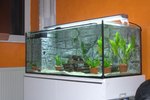
A refugium provides a protected area for organisms such as algae and tiny crustaceans to grow protected from hungry fish in reef aquariums. The refugium allows a breeding colony of food organisms to populate enough that one or two individually trickle into the main aquarium at a time while preserving the bulk of the colony. Meanwhile, a refugium also makes a home for macroalgae, which absorb toxic nitrogen compounds like ammonia and nitrite. You'll plumb your refugium one of two ways, depending on the refugium's purpose.
Consider Your Critters
Aquarium hobbyist have two main reasons to have refugiums. They either want a food source or a nitrogen sink. If your refugium contains only macroalgae, you can situate the return pump in the refugium itself. However, if you keep copepods or other food organisms, you need to use a gravity drain as you would for an aquarium with a sump tank. These two goals are not mutually exclusive -- you can have copepods and algae in the same refugium -- but if you have food animals, you need to plumb it with a gravity drain.
A Greenhouse for Your Tank
If you plan on keeping macroalgae or live rocks without food animals, options for plumbing your refugium vary. You can keep the entire refugium in the sump and never have to worry about plumbing. You could plumb the refugium off the sump or main aquarium, with a return line powered by a submersible aquarium filter. If you go this route, plumb it as you would a sump tank, with a gravity drain off the main aquarium leading into the refugium, and a return pump at the other end of refugium.
Crustacean Smorgasbord
If you plan on feeding fish from your refugium, you have fewer options. You have to use gravity to get water from the refugium back into return to the aquarium. These prevents filter impellers from shredding desirable invertebrates. This means the refugium has to be somewhat higher than the main aquarium. Some designs hang off the main aquarium like a powerbox filter, with a lip higher than the water level. In this design, the water flow is generated by a pump in the main aquarium, which pumps water from the aquarium into the refugium actively and lets gravity pull water and food animals back into the main tank.
Placing the Refugium
Options exist for refugium placement, too. Some people prefer to leave their refugiums visible and treat them as a second point of interest. If you have attractive macroalgae or curstaceans, you may want to go this route. In this case, use a clear hang-on refugium or a small aquarium mounted higher than the aquarium. If you don't want it obvious, you can hide the refugium in the sump or place a hang-on style in the rear of the aquarium. Keep in mind that if you keep algae, you must provide a light source or the algae will die and rot.
References
Photo Credits
-
Comstock Images/Comstock/Getty Images




